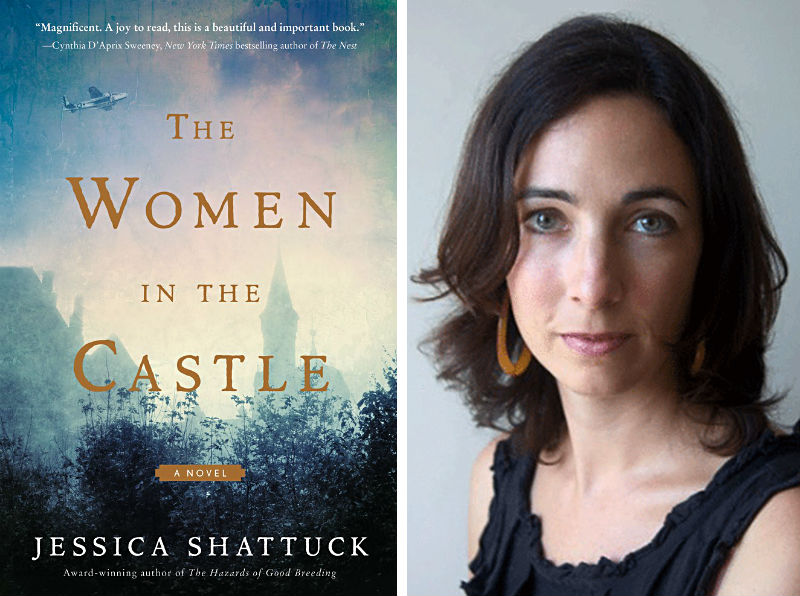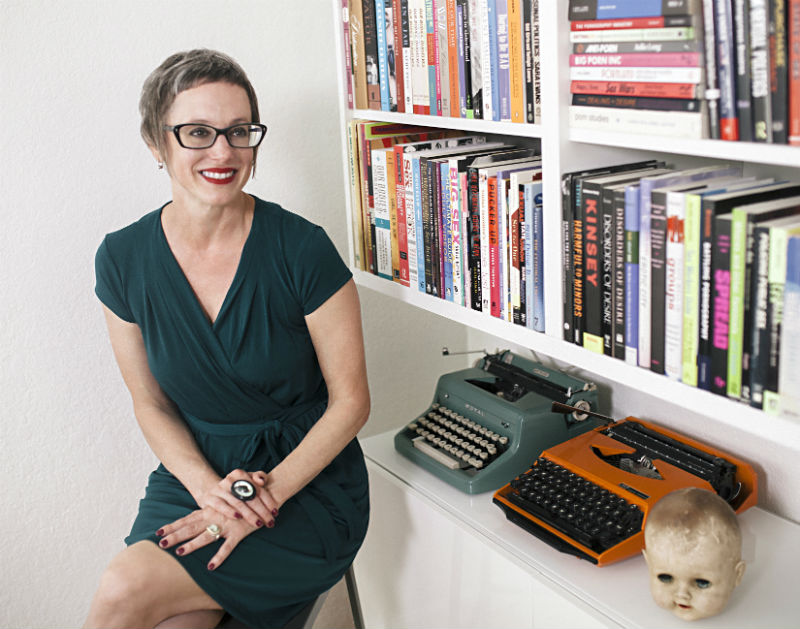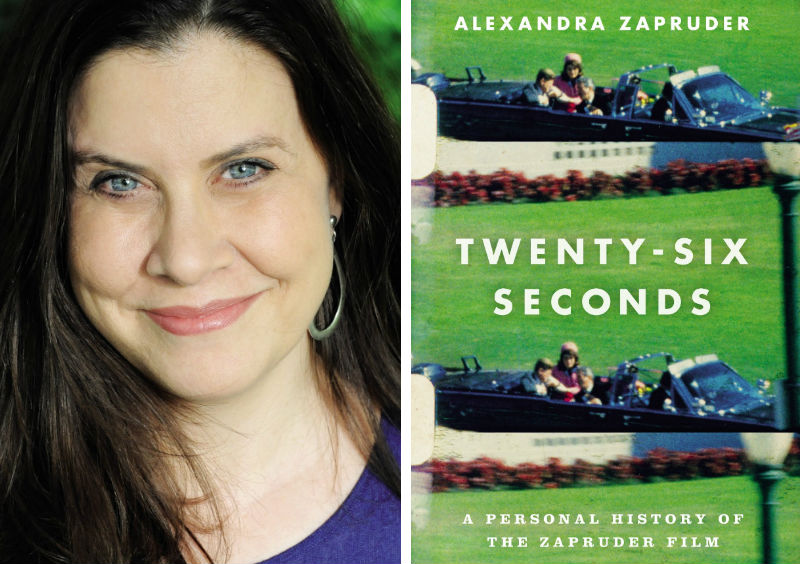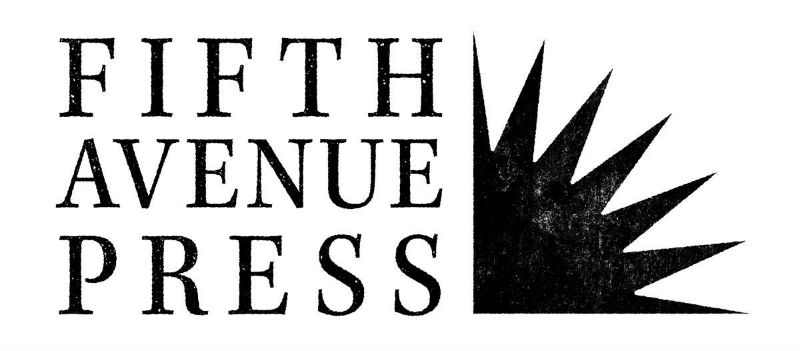Jessica Shattuck wrestles with her family's Nazi history in "The Women in the Castle"

Jessica Shattuck says that it wasn’t a big secret in her family. She always knew her grandparents were “ordinary Germans” during and before tWorld War II. “But in my late teens, I grasped that they had also enthusiastically joined the Nazi party in the late 1930s,” Sattuck said. Learning this family history from her grandmother prompted Shattuck to begin writing what became her new book, The Women in the Castle, which she'll read from, discuss, and sign at Nicola's Books on Friday, Jan. 12.
AADL 2017 Staff Picks: Books, Movies, Music & More

The list below is a collection of books, music, movies, and more that made an impression on our eyes and ears in 2017.
January 2018 Book & Author Events

What does having an amazing university, a plethora of fantastic local independent bookstores, and a pretty slam-bang public library system (if we do say so ourselves) bring to a town?
Authors. Lots and lots of authors.
In fact, so many authors pass through the area that sometimes it can be hard to keep track of who is speaking and when and where. To help guide you, Pulp curated a highlights list of January 2018 author events.
Townie Tales: Richard Retyi's "The Book of Ann Arbor" at Literati

On Dec. 7 at Literati, Richard Retyi read from his new book, The Book of Ann Arbor: An Extremely Serious History, which tells 41 townie tales in a humorous, accessible fashion.
But Retyi didn't originally set out to write a book. His project began as a podcast, Ann Arbor Stories, which Retyi produces with Brian Peters in partnership with the Ann Arbor District Library. (Retyi recently became the marketing and communications manager at AADL.) The podcast was modeled after another audio show, Memory Palace.
Poems Provoke: U-M's Institute for Research on Women and Gender discussed Petra Kuppers’ "PearlStitch"

The cover of Petra Kuppers’ PearlStitch is provocative. It draws the eye and keeps it as the viewer takes in an open mouth and an extended lace-covered tongue with a bead of clear fluid at its tip. Her poetry is provocative, too, and after the Nov. 29 panel of University of Michigan faculty members discussing PearlStitch as a part of the Institute for Research on Women and Gender’s "Gender: New Works, New Questions" series, I knew I wanted to dive into Kuppers’ latest collection. But I wasn't unable to put my hands on a copy of the book following the reading as Ann Arbor bookstores were sold out.
Balancing on the Edge of Motherhood: Anna Prushinskaya, "A Woman Is a Woman Until She Is a Mother"

The end of pregnancy is a strange time. You wait for the biggest change that can happen to a person other than death and yet, for most, you don’t know when the change will happen.
When will the baby be born? When will a woman become a mother?
When I was pregnant with my son, I read the title essay of A Woman Is a Woman Until She Is a Mother by Anna Prushinskaya probably 15 times. It became almost a talisman to me, a promise that he would eventually be born, that I would be able to cross over to motherhood.
When my water broke just like Anna described in her essay, unexpectedly and fast, I still had no idea what was coming. I was still perched between womanhood and motherhood.
In A Woman Is a Woman Until She Is a Mother, Prushinskaya writes beautifully about her experience balancing between places, between states: between pregnancy and motherhood, and between her Soviet homeland and her current home of Ann Arbor.
I spoke with Prushinskaya about her experience writing the book, how motherhood has changed her as a writer, and the birth of her second son. Our conversation has been lightly edited for clarity.
Q: Your essay “Uncertainty: Or a Woman Is a Woman, and Then Sometimes She Is a Mother” meant so much to me as I was preparing for the birth of my son. The description of your house shifting after your son’s unexpected home birth sticks with me -- it encompasses so much that is heartbreaking and wonderful about birth. You also had your second child at home, right? How did that change the feel of your house?
A: I’m so happy to hear that reading that essay was helpful -- one of the wonderful things about publishing these essays has been getting the chance to hear more birth stories and other experiences related to pregnancy, birth, motherhood (or not). I did end up having my second son at home, too. I don’t think I will ever feel the same about school buses! I live by a school, and right around the time my second son was born, I could see the school buses lining up through the windows. Now around that time if I’m home, I’m taken back to the birth, even if for a moment.
Q: One of the most profound changes that I went through after giving birth was a sudden, almost painful, tenderness, as though I had lost all of my armor. I’m so impressed with your ability to stay articulate in your writing through the postpartum emotional landscape. Was that difficult?
A: Actually, the experience of writing this felt similar to my experience of growing a baby and giving birth, in that I also sort of felt like a portal for the writing. Writing this book, the writing just sort of flowed, and I haven’t experienced that kind of creative energy since. So, it was surprisingly easy to get the pages written in that way, although I agree with you, for me the postpartum emotional openness was also wild. The more difficult aspect of working on this book was being more open with the world about my experiences, and I doubt I would have been able to write this book and allow for that kind of openness without the context I was writing in. (Though I don’t think pregnancy and birth exclusively allow for this kind of experience -- I imagine other trying and transformative life experiences can carry the same kind of energy.)
Q: Your book includes photographs between each essay. What made you decide to include these?
A: MG Press, my publisher, also puts out a journal called Midwestern Gothic, in which the work of Midwestern photographers is featured alongside writing. My publisher suggested that I have a look through the MG photos for possible interstitials for the book. I had been thinking about how to create pauses between the essays, and I wanted the pauses to invoke a similar feeling of an imprint in time. So I found the images sort of serendipitously within the MG photo collection.
Q: What has been the most surprising way that motherhood has changed you as a writer?
A: I’m not sure if it’s a direct correlation, but becoming a mom made me want to have more direct impact through my writing. For example, I wanted to learn more about the 1,4-dioxane pollution here in our area and ended up writing some stories on the issue about one year after my first son was born.
Q: The last essay in the book takes the form of a short play. What made you chose to write it this way, and why did you pick this piece to end the book?
A: I mention the 36 questions to love study in the book, the study I came across in The New York Times, which “explores whether intimacy between two strangers can be accelerated by having them ask each other a specific series of personal questions.” I was thinking about my relationship with the baby, who felt sort of like a stranger though I was already in love with him, and I was also with the baby for long stretches of time, which I remember as feeling very strange at first. So, that’s the inspiration for that piece. I liked that piece as the end because for me motherhood creates more questions than answers.
Q: You mention a wide variety of writers throughout this book. Is there a book or author that you return to over and over again?
A: Yes, definitely! I have a few that I have returned to a couple of times, including many of the authors I mention throughout the book. Right now the book I am re-reading is Pema Chödrön’s When Things Fall Apart: Heart Advice for Difficult Times.
Q: Other than the library, where can folks find your book?
A: In Ann Arbor, folks can stop by Literati Bookstore. Also, there are a few options for buying online.
Evelyn Hollenshead is a Youth Librarian at the Ann Arbor District Library.
Anna Prushinskaya will do a quick Michigan book tour for "A Woman Is a Woman Until She Is a Mother" in spring 2018, kicking off at Literati around early April.
Midwest Meditations: Cal Freeman, "Fight Songs" at Literati

“This is a lot of people for a poetry reading," said writer Cal Freeman. "I’ve read for three people before.” On Nov. 11, Michigan poet Freeman read from his new book, Fight Songs, at Literati bookstore. The crisp November evening seemed perfect for listening to regionally focused poetry as the temperature made its way downward.
Freeman is the kind of poet I would have spent a semester in a creative writing class peeking at over a copy of the latest student work being workshopped. He’s tall, though not quite lanky, and was dressed in mostly gray. I wouldn’t describe his look as rumpled, but the word crossed my mind. Very Midwestern.
She's Picking Up Good Vibrations: Lynn Comella, "Vibrator Nation" at Literati

When it comes to other adults’ sexual choices, I’m very live and let live. And in my personal life, I’m very willing to make a joke or tell a story laden with sexual innuendo, and I’ve long ago accepted that I’m the person who will robustly fall face-first into a strange double-entendre, I found myself a bit shy at the bookstore when I purchased my copy of Lynn Comella’s Vibrator Nation in advance of attending her discussion of the book which took place on November 14th at Literati.
This book was based on more than 80 in-depth interviews with sex-toy shop owners, employees of said stores, and pornographers. Comella herself worked at Babeland in New York City, which provided her ethnographic access from both sides of the sales counter. Her book synthesizes this and examines the role of feminist sex-toy stores on the larger adult industry.
Why study sex-toy shops?
Comella knew to answer that question for the audience right away.
It turns out that this project began as a part of her graduate coursework. She had taken a field methods class in cultural studies and had an interest in sexual politics. The class required her to conduct a small-scale ethnographic project. She asked herself, "Where are the places that women can be sexual subjects as opposed to sexual objects?" As a part of her work, she spoke with Aileen Journey, the owner of a store called Intimacies, which had just opened in the town where she studied. The owner told Comella that she saw her store as a feminist way to empower women and that she had modeled her store after Good Vibrations, a store that had opened in the 1970s in San Francisco’s Mission District.
Good Vibrations shared the idea that sex education could be empowering and helped Journey on the road to establishing her own store. This help included selling a vendor list for a mere $50 -- such magnanimity is an anomaly in the business world. But it turns out that this, as Comella calls it, “non-competitive ethos” was a reason why some saw the businesses as activism.
In 2008, there was a shift in the adult store industry. According to Comella, before this point, the industry had catered to the perceived desires of stereotypical men. She argues that 2008 was a game-changer due to both the recession and also the proliferation of free Internet pornography. Suddenly, the women’s market became appealing, as it was a rare growth area in the industry. Comella, however, became interested in the history of this already growing market, which had been building since the early 1970s.
Comella read from a chapter in her book titled “Living the Mission,” where she talked about the lived experience of working at Babeland. Here, she says, “Every shift I worked at Babeland put me on the front lines of its mission, which was ‘to promote and celebrate sexual vitality by providing an honest, open and fun environment, encouraging personal empowerment, educating our community and supporting a more passionate world for all.’”
Feminism provided a healthy dose of friction inside of this passionate world. For example, early on, men weren’t allowed into some of these spaces. Joani Blank of Good Vibrations, however, recognized that not all men were comfortable in the more traditional shops and that her store was appealing to some men. These business owners, then, were forced to decide whether or how to include men. Feminism also complicated things, raising the question of how erotic videos fit into the equation. How does one respond to such a market demand when some of the feminist thought behind these shops was anti-pornography? How do shops adjust to the construction of feminism, how do they embrace intersectionality? How do they become trans-inclusive? How do these businesses remain responsive?
There was also the matter of what sort of bedfellows feminism and capitalism made. Some individuals felt that a store, a capitalist enterprise, was antithetical to feminism. Others feared that once the market for women-centered sex shops became viable it would be co-opted and would no longer be about empowerment, liberation, and education. Babeland faced this matter head-on. The store had sold shares to its employees, yet the management still felt like profits weren’t as important as the social work that they provided. The employees, now owners, disagreed.
Comella argues that it’s “easy to think about sexuality as something we own,” but larger forces that act upon sexuality, such as cultural norms and public policy, impact it.
In the Q&A portion of the evening, the audience’s questions pushed at the larger cultural forces. Economic class factored in, as Comella acknowledged. For instance, finding body-safe materials from ethical sources sometimes priced-out certain consumers. She also acknowledged that within the field that storeowners talk a great deal about gender equality and sexuality, but not as much about class or race. This presented her with a challenge; it’s difficult “to write about things people aren’t really talking about.”
In examining this segment of the adult industry, Comella answers many questions about the rise of the business and the circuitous paths that female and queer-friendly sex-positive sex-toy stores have taken. She also begs the question of what happens next within this dynamic trade.
Sherlonya Turner is the manager of the Youth & Adult: Services & Collections Department at the Ann Arbor District Library. She can be found diving headfirst into all sorts of projects over at sherlonya.net.
Personal View of a National Tragedy: Alexandra Zapruder's "Twenty-Six Seconds"

“My grandfather came to America hell-bent on becoming an American.” --Alexandra Zapruder
Alexandra Zapruder’s Twenty-Six Seconds tells the story of the 26-second home video, recorded by her grandfather Abraham, that came to be known as the Zapruder film, the one video that showed President Kennedy’s assassination. On Wednesday, Nov. 7, Zapruder spoke at the Ann Arbor District Library about her book to an audience of about 80.
Zapruder never thought that she would write this book. She grew up in Washington, D.C., in a family that rarely talked about the film. She said that she is often asked whether the film was taboo or somehow a secret in her household. “It wasn’t that,” she said.
Fifth Avenue Press launches nine titles with a book release party

"Publishing is a business," writes mega-selling author Nicholas Sparks (The Notebook) in the "Advice for Writers" section of his website. "Writing may be art, but publishing, when all is said and done, comes down to dollars."
Except with Fifth Avenue Press, the new publishing imprint of the Ann Arbor District Library.
Fifth Avenue helps local authors produce a print-ready book at no cost -- from copyediting to cover design -- and the writers retain all rights. In return, the library gets to distribute ebooks to its patrons without paying royalties, but authors can sell their books -- print, digital, or audio -- however they choose and keep all the proceeds.
Fifth Avenue launches on Sunday, Nov. 5, with a reception from 1-3 pm on the 3rd floor of AADL's downtown branch, featuring author readings from the imprint's first nine titles:


































